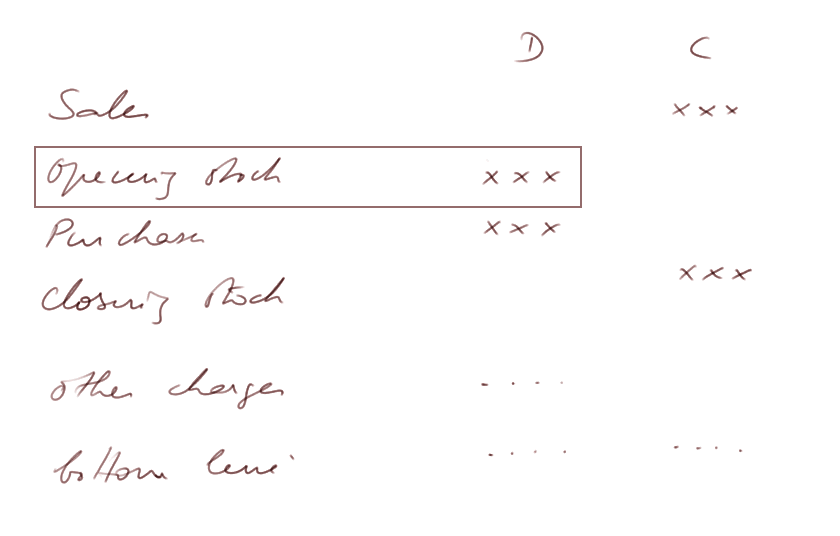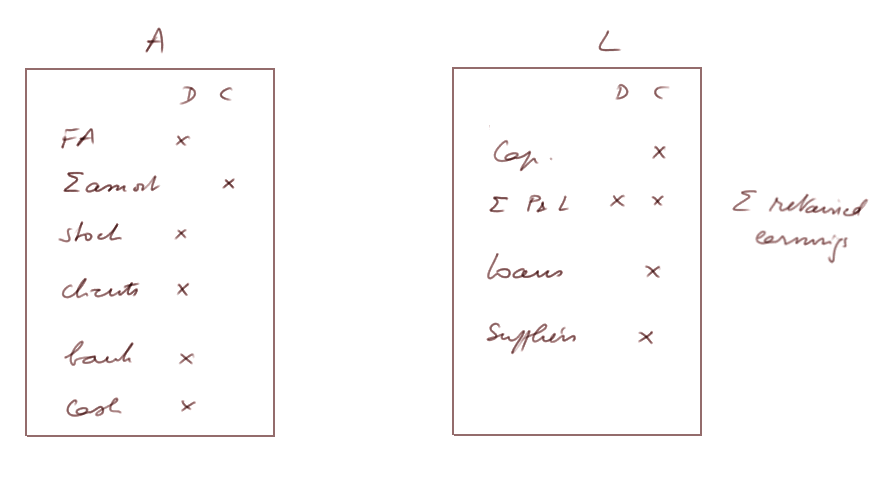General accounting
IX. 33. Differences between the 1st accounting cycle and the following ones
Video
We studied so far the 1st accounting cycle of a firm.
We used, for illustration, a shop buying and selling goods without manufacturing transformation. (See also a digression on the prices of goods and services.)
It was the first year of its life.
There is one specificity of the first year: at the beginning, all the accounts of the ledger are empty.
During the 1st cycle, we posted all the normal transactions into accounts.
Some accounts are called "Revenue accounts". They are the Sales and the yearly Expenditures to operate the firm.
Some accounts are called "Capital accounts". They are the Assets and the Liabilities.
At the end, we made some "adjustments" in order, in the Income Statement, to have exactly the charges of the year to produce the sales.
This is done via entries in extra revenue accounts (to which I added the suffix IS) and extra capital accounts (suffix BS).
For instance, an adjustment for prepayment consists in decreasing a charge (when a part of it concerns only next year) by passing a credit in an account called "adjustment for prepayment IS", or simply in the account of the charge itself, and recording a debit in an account called "adjustment for prepayment BS" (or simply "prepayments"), which corresponds to an extra temporary asset.
All the revenue accounts balances form the Income Statement. And all the other accounts balances, to which we add the balance of the IS, form the Balance Sheet.
The opening stock in the 1st accounting cycle was of course nil.
Then at the end of the cycle:
- in the IS we introduced a "closing stock IS" in credit, which has the effect of reducing the Purchases to the exact COGS
- in the BS we have a corresponding "closing stock BS" in debit.
Now comes the 2nd cycle:
- all the revenue accounts begin anew, that is to say empty
- all the capital acccounts have a beginning entry: their balance at the end of the year before
A closer look at Stocks: the closing stock (BS) of the year before, becomes the opening stock (IS) of the new cycle.
A closer look at Amortization:
- the yearly amortization of the new cycle begins empty,
- at the end of the second year, this yearly amortization (IS) will be a figure in debit
- the account "amortization (BS)" begins with a figure in credit,
- to which the amortization of the new cycle will be added in credit
For this reason, the usual name of the account amortization (BS) is simply "cumulated amortization".
(The suffixes IS and BS are not standard in accounting. I use them only for clarification purposes.)
End of the 2nd cycle:
- we prepare the Trial balance as usual
- we make adjustments for the 2nd cycle as usual
- in the IS they are written in accounts that were empty
- in the BS they are added to the previous figures
We extract the IS of the 2nd cycle from the second TB. Then, in this TB, we replace, as we already did, all the revenue accounts with just the bottom line of the IS.
The IS of the 2nd cycle has the usual look:

Notice however that now we have a figure for opening stocks.
And we end up with the BS at the end of the 2nd cycle, which has the following look:

Observe the "Σ amort." (another name for "cumulated amortization") on the asset side, credit column.
And observe the "Σ P&L" on the liability side, which may be in debit (losses) or credit (profits) depending on how well the firm performed. We shall see later that another name for it is "Σ retained earnings".



